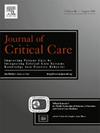An increase in skin blood flow after red blood cell transfusion is associated with an improvement in organ function in critically ill patients
IF 2.9
3区 医学
Q2 CRITICAL CARE MEDICINE
引用次数: 0
Abstract
Introduction
Red blood cell transfusions (RBCTs) are administered to critically ill patients to enhance tissue oxygen delivery. We investigated whether an increase in skin blood flow (SBF), a proxy for tissue perfusion, after RBCT was associated with improved organ function in non-bleeding intensive care unit (ICU) patients.
Methods
This secondary analysis of a prospective cohort included 175 adult ICU patients without acute bleeding who received a RBCT. Finger SBF was measured at basal temperature (SBFBT) using skin laser Doppler before and one hour post-RBCT: patients with a ≥ 20 % increase in SBFBT were classified as SBF responders. Patients were also classified as having high (>73 PU) or low (≤73 PU) baseline SBFBT, based on the optimal pre-transfusion SBFBT threshold for predicting SBF response. Patients with a ≥ 1 point reduction in Sequential Organ Failure Assessment (SOFA) score within 24 h post-RBCT were classified as “SOFA responders”. The primary outcome was the association between SBF responder status and SOFA responder status.
Results
Of 175 patients, 103 (58.9 %) improved SOFA. There was a trend of more SBF responders in the SOFA responders than in the SOFA non-responders group (51/103 [49.5 %] vs. 26/72 [36.1 %]); p = 0.08), respectively. SBF responder status (n = 77, 44 %) independently predicted a decreased SOFA score post-RBCT (OR 2.64, 95 %CI 1.25–5.41, p = 0.01).
Conclusions
An increase in SBFBT after RBCT was independently associated with a reduction of 1 point in SOFA score within 24 h after RBCT. These findings highlight the potential role of RBCT in improving tissue perfusion and organ function in acute illness.
输血后皮肤血流量的增加与危重病人器官功能的改善有关
红细胞输注(RBCTs)用于危重患者以增强组织氧输送。我们研究了非出血重症监护病房(ICU)患者在RBCT后皮肤血流量(SBF)的增加是否与器官功能改善有关,SBF是组织灌注的一个指标。方法对175例接受RBCT检查的无急性出血的成年ICU患者进行前瞻性队列分析。在rbct前和rbct后1小时,使用皮肤激光多普勒测量手指SBF的基础温度(SBFBT): SBFBT升高≥20%的患者被分类为SBF应答者。根据预测SBF反应的最佳输血前SBFBT阈值,将患者分为高(73 PU)或低(≤73 PU)基线SBFBT。rbct后24小时内顺序器官衰竭评估(SOFA)评分降低≥1分的患者被归类为SOFA应答者。主要结局是SBF应答者状态和SOFA应答者状态之间的关联。结果175例患者中,SOFA改善103例(58.9%)。SOFA应答组的SBF应答者多于SOFA无应答组(51/103[49.5%]比26/72 [36.1%]);P = 0.08)。SBF反应状态(n = 77, 44%)独立预测rbct后SOFA评分下降(OR 2.64, 95% CI 1.25-5.41, p = 0.01)。结论RBCT后SBFBT升高与术后24 h SOFA评分降低1分独立相关。这些发现强调了RBCT在改善急性疾病组织灌注和器官功能方面的潜在作用。
本文章由计算机程序翻译,如有差异,请以英文原文为准。
求助全文
约1分钟内获得全文
求助全文
来源期刊

Journal of critical care
医学-危重病医学
CiteScore
8.60
自引率
2.70%
发文量
237
审稿时长
23 days
期刊介绍:
The Journal of Critical Care, the official publication of the World Federation of Societies of Intensive and Critical Care Medicine (WFSICCM), is a leading international, peer-reviewed journal providing original research, review articles, tutorials, and invited articles for physicians and allied health professionals involved in treating the critically ill. The Journal aims to improve patient care by furthering understanding of health systems research and its integration into clinical practice.
The Journal will include articles which discuss:
All aspects of health services research in critical care
System based practice in anesthesiology, perioperative and critical care medicine
The interface between anesthesiology, critical care medicine and pain
Integrating intraoperative management in preparation for postoperative critical care management and recovery
Optimizing patient management, i.e., exploring the interface between evidence-based principles or clinical insight into management and care of complex patients
The team approach in the OR and ICU
System-based research
Medical ethics
Technology in medicine
Seminars discussing current, state of the art, and sometimes controversial topics in anesthesiology, critical care medicine, and professional education
Residency Education.
 求助内容:
求助内容: 应助结果提醒方式:
应助结果提醒方式:


